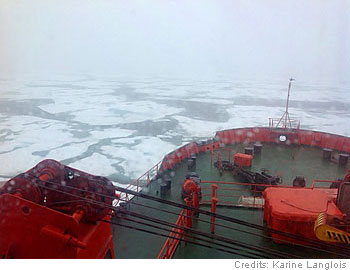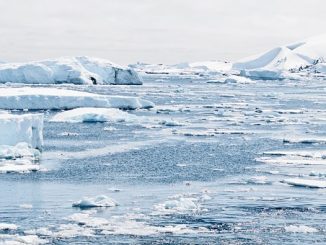By some accounts, the decline of Arctic sea ice to a modern low in 2012 put us on the verge of a shipping boom that could make the world’s northernmost sea lanes look like the Santa Monica Freeway at rush hour.
It did not work out that way. Not this year, at least.
To be sure, there have been some notable shipping stories in the far north recently. Just this week, a freighter with a hull reinforced against ice was due to arrive at a Norwegian port after carrying a load of Canadian metallurgical coal from British Columbia. That ship, the M/V Nordic Orion, became the first bulk carrier to traverse Canada’s Arctic archipelago via the Northwest Passage, a route that was sought for centuries by sailors who dreamt of a shortcut from the Atlantic to the Pacific.
Farther east, the Chinese-owned container vessel Yong Sheng drew worldwide attention as it carried a shipment of steel and machinery from the Chinese port of Dalian to the European shipping hub of Rotterdam. Rather than the usual route via the Suez Canal, Yong Shang transited the Arctic Ocean along Russia’s north coast over the Northern Sea Route. The Arctic route shaved about two weeks off what is typically a 48-day voyage, the ship’s owner said.
Yong Sheng was reportedly the first container ship to traverse the Arctic, although fuel and bulk carriers have sailed Russia’s inshore waters for years. In 1942, the German Navy even undertook an operation called Wunderland to intercept and sink shipping in what was then Soviet Union’s sector of the Arctic.
But despite these accomplishments, it has been a difficult season for Arctic shipping, for the unsurprising reason that there was more ice than last year. Considerably more ice, in fact. The Northwest Passage never truly became ice-free, and there were small stretches along the Northern Sea Route that retained at least some ice cover (albeit scattered and thin) through the summer and into the fall.
Through Sept. 30, only 28 freight-carrying vessels had transited the Northern Sea Route, according to Russian government statistics. Those vessels carried about 1 million metric tons of cargo. A total of 46 freighters made the journey in 2012, carrying around 2 million tons of goods. Moscow-based blogger John Helmer observes that at the peak of Soviet-era Arctic shipping, in 1987, some 7 million tons of freight were carried, though most of that was merely between Russian ports.
Some additional traffic should clear the Northern Sea Route before the season shuts down around the beginning of December. (It sounds strange to hear that ships are still able to cross the Russian Arctic so late in the year, when air temperatures are far below freezing and daylight is almost nonexistent. Navigation remains possible mainly because the freight traffic at that time is assisted by icebreakers and because ocean water, due to its salt content, does not freeze until its temperature drops to around 28 degrees Fahrenheit.) Still, trans-Arctic shipping is minuscule compared to the volume routed via the Suez Canal or around the Horn of Africa.
It is also, for the most part, not economically competitive. The Canadian voyage of the Nordic Orion would not have occurred but for a big Canadian subsidy, in the form of taxpayer-funded icebreaker support. Russia’s Arctic shipping agency extracts steep tolls in exchange for its services, which include a network of service and rescue stations and a new fleet of nuclear-powered icebreakers, both of which are under development and scheduled to be in full service by the end of this decade.
Much of the current activity is aimed at supporting national claims to sovereignty over resource-rich and strategically important Arctic waters. Canada may be willing to provide icebreaker service gratis, but it requires shippers to obtain a Canadian license before transiting its northern archipelago. This is partly to rebut claims, by the United States and others, that shipping lanes through the Canadian islands should be open to all flags under international law.
The Russians, for their part, are eager to claim and exercise sovereignty over a large part of the Arctic basin. This is probably why Russia reacted harshly to a Greenpeace publicity stunt directed at a Russian-owned drilling platform. Russia has brought piracy charges – carrying the potential for 15-year prison sentences – against all 30 people who were aboard the Greenpeace vessel, Arctic Sunrise, that defied Russian orders to stay away from the drilling vessel. The piracy charge is based on a reported attempt by two activists to board the drilling rig, where they have said they planned to hang a protest banner.
Maybe future shrinkage of the Arctic ice mass will produce a rush hour at the top of the world during my lifetime. Maybe it won’t. For the time being, however, it looks like an open road – if you don’t mind the ice.
- Bulenox: Get 45% to 91% OFF ... Use Discount Code: UNO
- Risk Our Money Not Yours | Get 50% to 90% OFF ... Use Discount Code: MMBVBKSM
Disclaimer: This page contains affiliate links. If you choose to make a purchase after clicking a link, we may receive a commission at no additional cost to you. Thank you for your support!




Leave a Reply